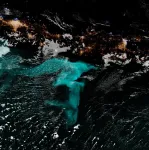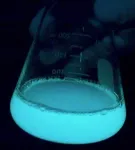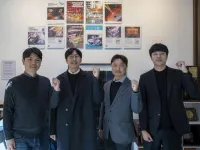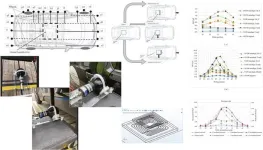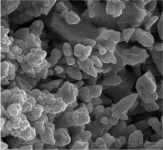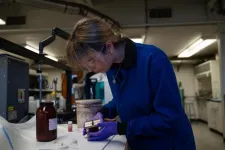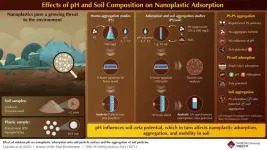(Press-News.org) For generations, sailors around the globe have reported a mysterious phenomenon: Vast areas of the ocean glow steadily at night, sometimes for months on end. The light is bright enough to read by and is oddly similar to the green and white aura cast by glow-in-the dark stars that have decorated children’s rooms. Stretching over ocean space as broad as 100,000 square kilometers, the light can, at times, even be seen from space.
This rare bioluminescent display was coined by sailors as “milky seas.” Despite being encountered for centuries, scientists still know very little about what causes this glowing effect because they are quite rare – they usually occur in the remote regions of the Indian Ocean, far from human eyes. A likely theory is that the glow comes from activity by a luminous microscopic bacteria called Vibrio harveyi.
To better predict when milky seas will occur, researchers at Colorado State University have compiled a database of sightings over the last 400 years. Described in the journal Earth and Space Science, the archive includes eyewitness reports from sailors, individual accounts submitted to the Marine Observer Journal over an 80-year period, and contemporary satellite data. This is the first such collection of data on milky seas in 30 years. Together, it shows that sightings usually happen around the Arabian Sea and Southeast Asian waters and are statistically related to the Indian Ocean Dipole and the El Niño Southern Oscillation.
Both of those climate phenomena are known to impact global weather patterns, prompting researchers to wonder how the dazzling phenomenon may be connected to those processes.
Justin Hudson, a Ph.D. student and the paper’s first author, said the database will help researchers better anticipate when and where a milky sea will occur. The goal, he said, is to get a research vessel out to the site in time to collect information about the biology and chemistry within a milky sea. Information about those variables could be helpful to connecting the event to broader Earth systems activity.
Hudson added that the regions where milky seas occur feature a lot of biological diversity and are important economically to fishing operations.
“It is really hard to study something if you have no data about it,” Hudson said. “To this point, there is only one known photograph at sea level that came from a chance encounter by a yacht in 2019. So, there is a lot left to learn about how and why this happens and what the impacts are to those areas that experience this.”
What are the milky seas and how do they form?
Bioluminescence comes in many forms across nature. One of the most common examples is a firefly’s flickering taillight. With milky seas, though, researchers are still trying to understand what is actually happening at the sea surface.
One hint comes from a research vessel that had a chance encounter with a milky sea in 1985, which was able to collect a water sample. Researchers found that a specific strain of luminous bacteria was living on the surface of algae within a bloom – possibly causing an even glow in all directions. However, that is just one data point and could be misleading. To bridge the gap in understanding, researchers have tried to leverage information gathered from sporadic satellite imagery.
Hudson said that, because of the regions most associated with the phenomenon, it seems likely the light is due to a biological process related to the bacteria.
“The regions where this happens the most are around the northwest Indian Ocean near Somalia and Socotra, Yemen, with nearly 60% of all known events occurring there. At the same time, we know the Indian monsoon’s phases drive biological activity in the region through changes in wind patterns and currents,” he said. “It seems possible that milky seas represent an understudied aspect of the large-scale movement of carbon and nutrients through the Earth system. That seems particularly likely as we learn more and more about bacteria playing a key role in the global carbon cycle both on land and in the ocean.”
Professor Steven Miller is the other author on the paper and has been conducting research on milky seas for years at CSU. He has led efforts to image the phenomenon from satellites and said the database should present new opportunity to get first-hand knowledge.
“Milky seas are incredible expressions of our biosphere whose significance in nature we have not yet fully determined,” Miller said. “Their very existence points to unexplored connections between the surface and the sky, and between microscopic to the global scale roles of bacteria in the Earth system. With the help of this new database, forged from sea-faring ships of the 17th century all the way to spaceships of modern times, we begin to build a bridge from folklore to scientific understanding.”
The paper represents a portion of Hudson’s research at CSU in the Department of Atmospheric Science as he works to finish and defend his thesis on the subject this summer. He said he hopes the database will further illuminate our understanding of the phenomenon.
“We have no idea what milky seas mean for the ecosystems they are found in. They could be an indication of a healthy ecosystem or distressed one – the bacteria we suspect are behind it are a known pest that can negatively impact fish and crustaceans,” he said. “Having this data ready allows us to begin answering questions about milky seas beyond hoping and praying a ship runs into one accidentally.”
END
With new database researchers may be able to predict rare milky seas bioluminescent, glowing event
Researchers have compiled a database of sightings over the last 400 years
2025-04-09
ELSE PRESS RELEASES FROM THIS DATE:
Enhancing power distribution systems with renewable energy: a new configuration approach
2025-04-09
A groundbreaking study presents a comprehensive approach to restructuring medium-level voltage (MLV) distribution systems that enhances reliability while reducing both energy losses and carbon emissions.
The study introduces an innovative "N+1 bus configuration" for radial distribution systems (RDS) - a simple yet powerful modification to conventional power networks that adds just one additional tie line to existing systems. This seemingly minor change delivers remarkable improvements in system performance when combined with distributed renewable energy resources (DER).
The research team conducted extensive testing on both real-time radial ...
Engineers bring sign language to ‘life’ using AI to translate in real-time
2025-04-09
For millions of deaf and hard-of-hearing individuals around the world, communication barriers can make everyday interactions challenging. Traditional solutions, like sign language interpreters, are often scarce, expensive and dependent on human availability. In an increasingly digital world, the demand for smart, assistive technologies that offer real-time, accurate and accessible communication solutions is growing, aiming to bridge this critical gap.
American Sign Language (ASL) is one of the most widely used sign languages, consisting of distinct hand gestures that represent letters, ...
Bad breath, bad news: how gum disease could worsen liver conditions
2025-04-09
There is growing recognition in medicine that what happens in one part of the body can ripple through others. That idea is now being explored in a surprising place: the mouth. A new review by an international group of researchers has examined the mounting evidence linking periodontal disease—commonly known as gum disease—to chronic liver conditions, including cirrhosis, metabolic dysfunction-associated steatotic liver disease (MASLD), and alcohol-related liver disease. Though the mouth and liver are separated ...
Lighter and more flexible solar cells achieve world’s highest efficiency
2025-04-09
The Korea Institute of Energy Research (President Yi Chang-keun, hereinafter referred to as “KIER”) has successfully developed ultra-lightweight flexible perovskite/CIGS tandem solar cells and achieved a power conversion efficiency of 23.64%, which is the world’s highest efficiency of the flexible perovskite/CIGS tandem solar cells reported to date. The solar cells developed by the research team are extremely lightweight and can be attached to curved surfaces, making it a promising candidate for future applications in buildings, vehicles, aircraft, and more.
Crystalline silicon-based single-junction solar cells ...
Vehicle-mounted wireless power transfer: ensuring safety through magnetic field management
2025-04-09
A comprehensive study has examined the magnetic field emissions (MFE) from vehicle-mounted wireless power transfer (WPT) systems, providing critical insights for ensuring user safety during electric vehicle charging. As wireless charging technology gains popularity for fleet vehicles and accessibility applications, understanding and controlling electromagnetic field exposure becomes increasingly important.
Researchers conducted extensive physical measurements around a vehicle equipped with an in-house designed WPT system, examining how various factors affect magnetic field emissions where users might be positioned during charging operations. The study specifically investigated:
- ...
Finding cancer’s ‘fingerprints’
2025-04-09
Cancer diagnoses traditionally require invasive or labor-intensive procedures such as tissue biopsies. Now, research published in ACS Central Science reveals a method that uses pulsed infrared light to identify molecular profiles in blood plasma that could indicate the presence of certain common cancers. In this proof-of-concept study, blood plasma from more than 2,000 people was analyzed to link molecular patterns to lung cancer, extrapolating a potential “cancer fingerprint.”
Plasma is the liquid portion of blood, depleted of any ...
Starch-based microplastics could cause health risks in mice, study finds
2025-04-09
Wear and tear on plastic products releases small to nearly invisible plastic particles, which could impact people’s health when consumed or inhaled. To make these particles biodegradable, researchers created plastics from plant starch instead of petroleum. An initial study published in ACS’ Journal of Agricultural and Food Chemistry shows how animals consuming particles from this alternative material developed health problems such as liver damage and gut microbiome imbalances.
“Biodegradable starch-based plastics may not be as safe and health-promoting as originally assumed,” ...
A step toward cleaner iron extraction using electricity
2025-04-09
Iron and its alloys, such as steel and cast iron, dominate the modern world, and there’s growing demand for iron-derived products. Traditionally, blast furnaces transform iron ore into purified elemental metal, but the process requires a lot of energy and emits air pollution. Now, researchers in ACS Energy Letters report that they’ve developed a cleaner method to extract iron from a synthetic iron ore using electrochemistry, which they say could become cost-competitive with blast furnaces.
"Identifying oxides which can be converted to iron metal at low temperatures is an important ...
University of Oregon scientists advance a greener way to produce iron
2025-04-09
University of Oregon chemists are bringing a greener way to make iron metal for steel production closer to reality, a step towards cleaning up an industry that’s one of the biggest contributors to carbon emissions worldwide.
Last year UO chemist Paul Kempler and his team reported a way to create iron with electrochemistry, using a series of chemical reactions that turn saltwater and iron oxide into pure iron metal.
In their latest work, they’ve optimized the starting materials for the process, identifying which kinds of iron oxides will make the chemical reactions the most cost-effective. That’s a key ...
Nanoplastics in soil: how soil type and pH influence mobility
2025-04-09
Plastics are everywhere—from packaging and textiles to electronics and medical devices. As plastic waste breaks down, it releases microscopic particles that can penetrate our ecosystems, hinder plant growth, and potentially transfer harmful pollutants to organisms, including humans. Therefore, these plastic particles are a potential threat to the ecosystem, especially in their nanoparticulate form (1–100 nm diameter), which can penetrate the environment through different routes, including the soil beneath our feet.
With this in mind, a team of researchers from Japan set out to study the migration behavior of nanoplastics ...
LAST 30 PRESS RELEASES:
University of Oklahoma researcher awarded funding to pursue AI-powered material design
Exploring how the visual system recovers following injury
Support for parents with infants at pediatric check-ups leads to better reading and math skills in elementary school
Kids’ behavioral health is a growing share of family health costs
Day & night: Cancer disrupts the brain’s natural rhythm
COVID-19 vaccination significantly reduces risk to pregnant women and baby
The role of vaccination in maternal and perinatal outcomes associated with COVID-19 in pregnancy
Mayo Clinic smartwatch system helps parents shorten and defuse children's severe tantrums early
Behavioral health spending spikes to 40% of all children’s health expenditures, nearly doubling in a decade
Digital cognitive behavioral treatment for generalized anxiety disorder
Expenditures for pediatric behavioral health care over time and estimated family financial burden
Air conditioning in nursing homes and mortality during extreme heat
The Alps to lose a record number of glaciers in the next decade
What makes a good proton conductor?
New science reporting guide published for journalists in Bulgaria
New international study reveals major survival gaps among children with cancer
New science reporting guide published for journalists in Turkey
Scientists develop a smarter mRNA therapy that knows which cells to target
Neuroanatomy-informed brain–machine hybrid intelligence for robust acoustic target detection
Eight SwRI hydrogen projects funded by ENERGYWERX
The Lundquist Institute and its start-up company Vitalex Biosciences Announces Strategic Advancement of Second-Generation fungal Vaccine VXV-01 through Phase 1 Trials under $40 Million Competitive Con
Fine particles in pollution are associated with early signs of autoimmune disease
Review article | Towards a Global Ground-Based Earth Observatory (GGBEO): Leveraging existing systems and networks
Penn and UMich create world’s smallest programmable, autonomous robots
Cleveland researchers launch first major study to address ‘hidden performance killer’ in athletes
To connect across politics, try saying what you oppose
Modulating key interaction prevents virus from entering cells
Project explores barriers to NHS career progression facing international medical graduates
Jeonbuk National University researchers explore the impact of different seasonings on the flavor perception of Doenjang soup
Two Keck Medicine of USC Hospitals named Leapfrog Top Teaching Hospitals
[Press-News.org] With new database researchers may be able to predict rare milky seas bioluminescent, glowing eventResearchers have compiled a database of sightings over the last 400 years
